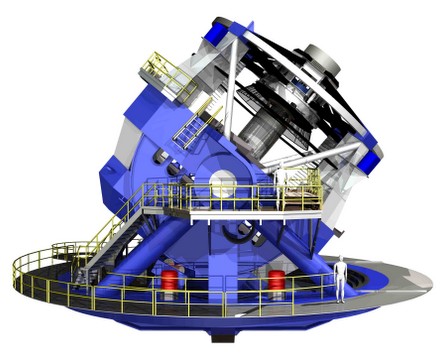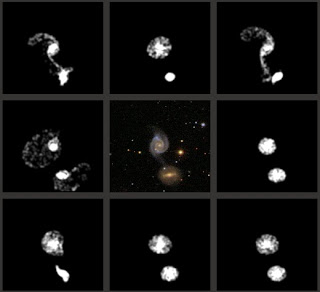This is a list of the 10 greatest modern astronomical observatories ever imagined. Some are being built presently, some are scouring for funding, and some are dreams. They are in no precise order, but I have tried to place them according to their extremeness with respect to scientific impact, cost, technology, and size.
1. Laser Interferometer Space Antenna
LISA is in a class of its own. In some sense it does not belong on this list because it literally transcends every other observatory on this list by monitoring the universe through gravitational waves and not electromagnetic waves. If LISA is successful it will be the first direct observation (unless a project like advanced
LIGO beats it to the punch) of gravitational waves which are predicted by Einstein's theory of General Relativity. LISA will detect the variation in distance of three spacecraft flying in an equilateral triangle formation. The LISA instruments are classic interferometers sensitive to gravitational waves which distort the space-time between the spacecraft by as little as just tens of pm. Soon the
LISA Pathfinder mission will be launched to prove the concept and technology necessary for the complete observatory. LISA is a profound step forward for humankind, like an infant opening its eyes for the first time.
2. Terrestrial Planet Finder
The
TPF is visionary space mission which will likely consist of two observatories in space a
coronagraph and an
interferometer array. The TPF will search for extrasolar terrestrial planets around relatively close stars like the
Alpha Centauri system and systems where the probability to find an extra solar planet is high. The coronagraph would be a very large optical telescope, at least three times that of Hubble, that would also have special optics to occult the light of bright stars in order to see the dim planets next to their brilliant host stars. The interferometer, illustrated above, would consist of several small infrared telescopes orbiting in formation; the interferometric technique would allow the telescopes to obtain a resolution of a much larger telescope.
3. James Webb Space Telescope
The
JWST is considered the successor to the Hubble Space Telescope. It will study galaxy, star and planet formation in the Universe with supreme depth and precision. Just imagine the
James Webb Ultra Deep Field. The telescope engineering is impressive. The telescope's primary mirror will consist of a 6.5 m (about 6 times the area of Hubble) gold coated beryllium refelector composed of 18 hexagonal segments which will unfold in space. The mirror is made of such special materials because of the need for specific thermal and reflective properties. For example beryllium is the metal with the greatest heat dissipation characteristics per unit weight and further its relatively low coefficient of thermal expansion imparts stability to the mirror. JWST is designed to observe very distant objects such that much of their light will be in the infrared when it reaches the telescope and therefore JWST will be an infrared telescope, hence the gold coated reflecting surface. JWST is packed with advanced technology like hemispherical resonator gyros which should last longer than the traditional mechanical gyroscopes which were on Hubble and needed servicing during missions. This is necessary because JWST will be far from earth at
Lagrange point two, some 1.5 million km from Earth and not close enough for simple repair missions. If all this sounds ambitious and outlandish that is because it is, but the science that the JWST will produce will certainly justify the effort.
4. Overwhelmingly Large Telescope
The
OWL is the most unlikely telescope on this list; the project has been eclipsed by the European Extremely Large Telescope, the
EELT, on all practical accounts. The OWL would be a unrealistically large 100 m telescope allowing it to observe objects as faint as an apparent magnitude of 38. In order to control costs the OWL would be based on mass production of major cost items like the structural components and segmented mirrors, but a review panel determined the cost would be at least 1.2 billion Euros. This cost is considered unacceptably high.
5. The Square Kilometer Array

The
SKA will be a radio telescope with a million kilometers of collecting area. It will be the largest telescope ever created and perhaps the most expensive at 1.5 billion Euro. The SKA will probe the gaseous component of the early Universe with sensitivity 50 times greater than the
Very Large Array. This sensitivity and a wide field of view will also allowing the SKA to probe general relativity by monitoring the timing of a network of pulsars. Like the VLA the SKA will be an
interferometric array consisting individual antenna stations working together to synthesize an aperture with a diameter up to several thousand kilometers. Many things about the final design for the SKA are uncertain, in fact factions within astronomy have threatened to doom the entire project. The disagreements stem from different opinions on what the primary scientific objectives should be for the project. Currently it is planned that approximately 50% of the collecting area would be contained in a dense central array of 5 km in diameter to provide high brightness sensitivity at arc-second scale resolution for studies of faint spectral lines from structures in the early universe. Another 25% of the collecting area would be located within a diameter of 150 km; the image above shows a possible layout for the array with arms in a spiral pattern with a diamter of 150 km. The remainng 25% of the collecting area would be at baselines of 3000 km or greater. The distribution of antennas directly impacts what kind of science can be accomplished. The video below shows a possible layout for the SKA in dramatic fashion.
6. European Extremely Large Telescope
The
EELT is the realistic result of the
OWL telescope proposal. The primary mirror will be 42 meters consisting of 984 1.4 meter segments of only 50 mm thickness. The mirrors are thin in order to have excellent thermal properties. The EELT will have an
adaptive optics system which will perform active adjustment of a 2.5 meter mirror to compensate for atmospheric affects which distort images. There will be 5000 actuators supporting this mirror which precisely adjust the mirror's shape thousands of times per second in order to correct images. The reality is that the limiting effect on all large ground based telescopes is atmospheric seeing, therefore all the ground based optical telescopes on this list use some kind of adaptive optics.
7. Large Synoptic Survey Telescope
The
LSST is an 8-meter telescope with a 3 degree field of view (consider that the moon is only half a degree in the sky). This design configuration allows the LSST to implement an observing program that detects near-Earth objects which are small and faint in exposures of 10 or 20 seconds, and it allows images to be stacked for deep and wide imaging for star and galaxy surveys. The science mission drivers of LSST include the nature of dark energy, the solar system, optical transients, and galactic structure. It is the
LSST technology and the rate at which it will produce data that makes it so remarkable. The
LSST camera is 3200 Megapixels (it is a giant array of 189
CCD chips) and will create 400,000 sixteen Megapixel images per night (resulting in about 30 TB) for a total of 60 PB of raw data over 10 years. The total data volume after processing will be over 100 PB requiring 250 TFlops of computing power for processing. LSST will be wide, fast, and deep. It should be ready for first light by 2014.
8. Thirty Meter Telescope
The
TMT is another extremely large ground based telescope. Its design calls for a collecting area that is thirty meters or about 100 feet in diameter. In order to better explore the early universe it will be sensitive to light in the optical near infrared. Relative to the Hubble the TMT will have 144 times more collecting area and a factor of 10 better spatial resolution in the near-infrared. The TMT will have a primary mirror composed of 492 segments with a rotating tertiary mirror (as seen in the above image, a Ritchey-Chretien telescope) in order to direct light onto multiple instruments and it will of course use adaptive optics to correct for turbulence in earth's atmosphere. The TMT will implement a scaled of version of the segmented mirror technology of the Keck telescopes at a size which will produce significant science at a reasonable cost.
9. Giant Magellan Telescope
The GMT differentiates itself from the other giant ground based telescopes on this list in that its primary mirror will not be segmented in the standard manner, but will instead consist of seven monolithic 8.4 m mirrors. Because six of the mirrors are off-axis (they don't focus light to a point directly above them, but rather to a point off to their side; see image above) they present a unique engineering challenge that will synthesize a telescope with a resolving power of a single 24.5 m mirror. Currently the first mirror has been cast at the
Steward Observatory Mirror Lab as a proof of concept that an acceptably accurate shape can be achieved.
10. Atacma Large Submillimeter Array

ALMA is probably the most practical observatory on this list and it is almost already completed (
located in the Atacama desert), whereas many of the other observatories on this list are only the twinkle in astronomer's eyes. It is currently under construction in the thin (altitude of 5,000 m or 16,000 feet), dry air, of northern Chile. ALMA is not actually a single telescope, but an array of 50 (this number may change and has already been reduced once) antennae working in unison. It merits a place on this list because it will revolutionize astronomy by providing a senstive eye on mm wavelength light where early universe star/planet formation can be viewed best. Each of its 12 m antennas will observe in bands ranging fom 30 Ghz to 1 Thz and the array will have specialized telescope transporters which will enable baselines ranging from 150 m to 16 km. ALMA is only practical in respect to the grandiose telescopes on this list; it the the most ambitious ground-based telescope ever built and costs in excess of one billion US dollars.
The future of great astronomical observatories
This list is merely my musings on astronomical observatories. There are more productive observatories that have already built, or will be built, but these are the most exciting in my humble opinion. This list does not include even more speculative projects such as plans for a lunar radio telescope or an extremely sensitive and larger LISA. There are other planned observatories not mentioned, like
IXO, that just didn't make the list.
It is of note that there is an over arching principle of segmentation present in all of these observatories; these telescopes use multiple almost identical components working in unison in order to gather signal. LISA, the SKA, TPF, and ALMA use interferometry or correlation to observe. The EELT, TMT, JWST, use segmented primary mirrors. GMT uses several identical mirrors to simulate one primary mirror. LSST uses a massive array of CCD detectors. Modern technology and the economic/complexity benefits of reproducible industrial construction make this possible, but it takes modern computing to gather the data from the individual receiving elements and produce coherent observations and science.




























 Galaxy Zoo is the worlds largest astronomy collaboration with over a hundred thousand collaborators. I mentioned Galaxy Zoo some time ago, but since then they have doubled the number of
Galaxy Zoo is the worlds largest astronomy collaboration with over a hundred thousand collaborators. I mentioned Galaxy Zoo some time ago, but since then they have doubled the number of 
 The unique discovery of Hanny's Voorwerp was made possible only by the citizen scientists of the project. Hanny's Voorwerp is a green amoeba like blob next to a spiral galaxy that was discovered by a galaxy zoo volunteer, Hanny van Arkel, and hence the name of the object. It appears green in some optical images because of bright emission lines that dominate in the SDDS g band. Spectral analyis has shown that it is a highly ionized region leading to the hypothesis that it is the result of a powerful transient outburst because whatever energized the blob is now gone. Researchers hypothesize that Hanny's Voorwerp is
The unique discovery of Hanny's Voorwerp was made possible only by the citizen scientists of the project. Hanny's Voorwerp is a green amoeba like blob next to a spiral galaxy that was discovered by a galaxy zoo volunteer, Hanny van Arkel, and hence the name of the object. It appears green in some optical images because of bright emission lines that dominate in the SDDS g band. Spectral analyis has shown that it is a highly ionized region leading to the hypothesis that it is the result of a powerful transient outburst because whatever energized the blob is now gone. Researchers hypothesize that Hanny's Voorwerp is  The result of users classifying galaxies as mergers were 3000 prime candidates with which they wanted to compare to simulations. The goal of
The result of users classifying galaxies as mergers were 3000 prime candidates with which they wanted to compare to simulations. The goal of 

 This strange movie is a visual aggregation of the data which the Huygens lander gathered when landing on Saturn's moon
This strange movie is a visual aggregation of the data which the Huygens lander gathered when landing on Saturn's moon 


























 A servicing mission was planned for the 19-year-old Hubble Space Telescope years ago, but after the instrument command and data handling module failed the repair mission was postponed so that an even more comprehensive repair mission could be undertaken. Three months ago the space shuttle
A servicing mission was planned for the 19-year-old Hubble Space Telescope years ago, but after the instrument command and data handling module failed the repair mission was postponed so that an even more comprehensive repair mission could be undertaken. Three months ago the space shuttle 

